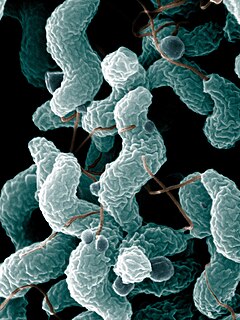Related Research Articles

Acidobacteriota is a phylum of Gram-negative bacteria. Its members are physiologically diverse and ubiquitous, especially in soils, but are under-represented in culture.

Thermus is a genus of thermophilic bacteria. It is one of several bacteria belonging to the Deinococcota phylum. Thermus species can be distinguished from other genera in the family Thermaceae as well as all other bacteria by the presence of eight conserved signature indels (CSIs) found in proteins such as adenylate kinase and replicative DNA helicase as well as 14 conserved signature proteins (CSPs) that are exclusively shared by members of this genus.

Campylobacterota are a phylum of bacteria. All species of this phylum are Gram-negative.
The Gemmatimonadota are a phylum of bacteria established in 2003. The phylum contains two classes Gemmatimonadetes and Longimicrobia.
The Chloroflexota are a phylum of bacteria containing isolates with a diversity of phenotypes, including members that are aerobic thermophiles, which use oxygen and grow well in high temperatures; anoxygenic phototrophs, which use light for photosynthesis ; and anaerobic halorespirers, which uses halogenated organics as electron acceptors.
Arcobacter is a genus of Gram-negative, spiral-shaped bacteria in the phylum Campylobacterota. It shows an unusually wide range of habitats, and some species can be human and animal pathogens. Species of the genus Arcobacter are found in both animal and environmental sources, making it unique among the Campylobacterota. This genus currently consists of five species: A. butzleri, A. cryaerophilus, A. skirrowii, A. nitrofigilis, and A. sulfidicus, although several other potential novel species have recently been described from varying environments. Three of these five known species are pathogenic. Members of this genus were first isolated in 1977 from aborted bovine fetuses. They are aerotolerant, Campylobacter-like organisms, previously classified as Campylobacter. The genus Arcobacter, in fact, was created as recently as 1992. Although they are similar to this other genus, Arcobacter species can grow at lower temperatures than Campylobacter, as well as in the air, which Campylobacter cannot.
Dactylosporangium is a genus in the phylum Actinomycetota (Bacteria).
Agromyces is a genus in the phylum Actinomycetota (Bacteria).
Alistipes is a genus in the phylum Bacteroidota (Bacteria).
Armatimonadota is a phylum of gram-negative bacteria.
Arcobacter skirrowii is a species of bacteria. It can be pathogenic.
Arcobacter cibarius is a species of Gram-negative, rod-shaped, slightly curved, non-spore-forming bacteria. LMG 21996T is its type strain.
Virgibacillus is a genus of Gram-positive, rod-shaped (bacillus) bacteria and a member of the phylum Bacillota. Virgibacillus species can be obligate aerobes, or facultative anaerobes and catalase enzyme positive. Under stressful environmental conditions, the bacteria can produce oval or ellipsoidal endospores in terminal, or sometimes subterminal, swollen sporangia. The genus was recently reclassified from the genus Bacillus in 1998 following an analysis of the species V. pantothenticus. Subsequently, a number of new species have been discovered or reclassified as Virgibacillus species.
Arcobacter bivalviorum is a species of Gram-negative, slightly curved, motile, rod-shaped bacteria first recovered from mussels and clams. Its type strain is F67-11(T)=CECT 7836(T)=LMG 26156(T)).
Arcobacter venerupis is a species of Gram-negative, slightly curved motile rod-shaped bacteria. It was first recovered from mussels and clams. Its type strain is F4(T)=CECT 7835(T)=LMG 26154(T)).
Arcobacter suis is a species of bacteria first isolated from pork meat. Its type strain is F41T.
Arcobacter cloacae is a species of bacteria first isolated from sewage. Its type strain is SW28-13T.
Arcobacter aquimarinus is a species of bacteria first recovered from mussels, with type strain W63T.
Arcobacter anaerophilus is a Gram-negative and non-motile bacterium from the genus of Arcobacter which has been isolated from sediment from the Gangasagar in India.
Arcobacter canalis is a bacterium from the genus of Arcobacter.
References
- ↑ Levican, Arturo; Rubio-Arcos, Sara; Martinez-Murcia, Antonio; Collado, Luis; Figueras, María José (2015). "Arcobacter ebronensis sp. nov. and Arcobacter aquimarinus sp. nov., two new species isolated from marine environment". Systematic and Applied Microbiology. 38 (1): 30–35. doi:10.1016/j.syapm.2014.10.011. ISSN 0723-2020. PMID 25497285.